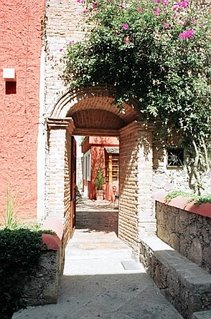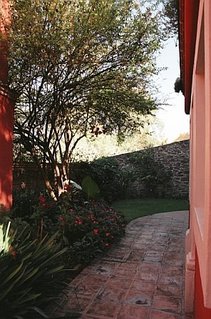I woke up about 30 or 40 minutes before we landed at "BJX" — León-Guanajuato Bajio International Airport. I've found myself able to sleep (or at least doze) more often on flights in the past few years. There was a time in the mid/late-1990s when almost every flight was a white-knuckle ride in which my imagination vividly took me into the vortex of a dizzying descent — sometimes fiery, sometimes eerily pitch-black and quiet — from a couple thousand feet above the ground. I'm really glad that I'm over that phobia. There's still a point during every flight when I have that "what if..." moment in which I over-empathize with poor unfortunate souls who've been in such harrowing mid-air "emergencies," but the feeling passes pretty quickly. And yeah, I'm now able to nap without starting awake in terror every time the captain flashes the seatbelt sign.
Waking up on the approach to Guanajuato, I looked out the window. It was about 9:00pm, so I couldn't see much. Yet, I was convinced somehow that the rooftops and the streetlights looked a little different somehow. The street patterns or something. The burst of a firework a few hundred yards from the airplane — yes, something was different. I thought briefly of another airplane descent, a long time ago, into Kano, Nigeria; I hadn't disembarked then, but I remember peering intently through the thick glass of the airplane, trying to take in everything that was different. I mostly wondered what this Mexican landscape would have looked like in the light of day.

Once we got to the airport and "deplaned" (is that really a verb?), there was still something so familiar yet "foreign" enough about the modern glass and metal terminal. Like the terminal in Lomé, Togo, which felt as if it could have been in Florida, but at the same time was clearly not in Florida at all.
Luckily, Bob was with me and, having made this trip so many times over the years, he was a pro at guiding me through anything that could have even remotely been an obstacle. Collected our luggage at the baggage carousel. Went through the customs document control line, then headed to the actual baggage-control area. This was potentially "fun": one's own personal game-of-chance in which you pushed a big button in order to find out if you were waved through (a friendly green light) or stopped and had your bags searched (a red light and you-picked-the-wrong-curtain-gameshow buzzer). I skated through on Bob's green light since we were "juntos."
We were picked up at the airport by Benito, a "friend of a friend's brother-in-law" (is there a kinship term for this in Latin America? Don't look at me, I was only an anthropology major...). I kept noticing important cultural differences in the airport parking lot: one of the Volkswagen models parked there was called a "Derby" (and I couldn't help wondering if the product marketing whizzes meant for it to be pronounced 'derby' or 'darby'...).
As we headed toward San Miguel via Guanajuato, I noticed the signs for other locales with intriguing names: One was Iratuapo. Another, Silao, looked vaguely Portuguese to my eye, but not particularly Mexican.
It was in Silao that we zoomed past a gargantuan real-live Mexican maquiladora — the kind one reads about in The Economist. It immediately occurred to me that it didn't look much different (if decidedly a bit newer and more sparkly) than the huge Ford plan on US-1 in Edison, New Jersey: You've seen one bone-crushing, soul-deadening arm of the industrio-capitalist machine, you've seen 'em all. I am so kidding! I totally love and embrace the manufacturing economy! All for naught did my own motherland become a notch in the rust belt.
As we skirted the edges of Guanajuato proper on the autopista (if that's what one could call the often-bumpy two-lane highway), I was (here we go again) reminded vaguely of Ghana. I can only distill my description of this feeling as a similarity — vague or vivid — in "developing world" landscapes and cityscapes. Some of the scenes that made me feel this way:
- corrugated metal rolling doors on the front of all kinds of stores and establishments; these were very noticeable since most businesses were closed at that time of night, but this is just not something one sees a lot of in my experience in the U.S.
- tiny "provisions shops" or tiendas that would pop up anywhere along the road; walk-in-closet-sized places with shelves stocked floor-to-ceiling with any and all types of food items, and inevitably sporting that beacon of the multinational food industry, a bright blue Nestlē logo.
- al fresco taco stands every couple of blocks: nothing more than a big old charcoal brazier, sitting on the sidewalk or right on the dirt at the side of the road, ready to serve up myriad delights. So potentially lipsmackingly yummy, and yet soooo scary.

I have wondered a lot if this tendency to perceive similarities might be a completely patronizing "first-worlder" view of things — as if I'm seeing the "griminess" and "rusticity" as some kind of quaint and charming World's Fair Exhibition... When in fact Guanajuato and Accra may be about as similar as Helsinki and Topeka.
In the end, I don't think I'm being unfair or ethnocentric or a particularly ugly American by recognizing some amorphous "Third World" similarities on the surface of things. A day or so after I had been observing this stuff, Bob said as much to me — wondering if I might be seeing and enjoying some similarities between Mexico and Ghana. I replied that yes, in fact, I had been, but I again questioned whether it was in some way patronizing to lump all these "undeveloped" countries into one basket just because they have open-air food stands propped up in the dust at the side of the road.
I'm well aware that one doesn't need to be the type who looks down one's nose at the "filth" in another country to be an ugly, biased turista. It's just as much of a pitfall to be the hug-fest type of tourist who loves the "charm" of the "common people" and does everything to Enjoy! and Appreciate! the Authenticity! of the campo! Please, Lord, let me not be exactly the latter GlobalExchange/Rotary International type of traveler. Let me walk some kind of middle ground of being able to eat tamales on the street while also thoroughly enjoying an icy cocktail in the courtyard of a luxury multinational hotel.
In any case, the urban outskirts of Guanajuato gave way to the long, winding, rural road to San Miguel de Allende. It reminded me in its empty openness of Highway 1 to Lompoc or the twisting black stretch of Highway 33 deep in Ventura County.
I notice road signs whenever I travel, and I try to remember them, no matter how mundane. Favor Disminuya su Velocidad. Directional signs pointing out "Celaya," "S.Mig. de Allende," "D. Hidalgo." Signs declaring that one is entering "La Fragua de la Independencia Nacional"... the "anvil" of independence. I first thought fragua must mean cradle, since that's the popular idiom that sprang to mind, but then I realized that cradle would be cuna. Only the next day did I learn from Bob that fragua means anvil. Does the USA have an "anvil" of independence? If not, why not? Are we more comfortable with independence being cradled and nurtured into being rather than hammered out in a hot, sweltering iron forge?
Finally, some of the most perplexing signs: No Maltrate las Señales.
The ride was beautiful, the road dark and mostly empty, with the lights of the distant towns, including San Miguel, twinkling. There were only a couple of incidents in which I felt my heart beat a little faster, having noticed the speed of the oncoming traffic, including a few fiercely growling dump trucks, on the narrow two-lane road, and just a couple of glimmering white crosses sprouting out along the roadside here and there. Always, encouraging reminders for the adventurous traveler.
Finally, the road wound into San Miguel after circling it and offering a good glimpse of the illuminated spire of the Parroquia. We descended slightly down a narrow but busy cobblestone road — a main thoroughfare known only as La Salida de Queretaro — that felt to me as if it could have been in the Albaicín of Granada. More tiny, inviting little shops that made me think of tins of powdered milk, tomato paste, and chocolate bars.
The taxi let us off at the base of Callejon Cruz del Pueblo, Bob's "street" — an irregular, somewhat narrow stairway-paseo. We passed through the garden wall from the paseo into what I considered a true idyll: quiet and cozy, with an amazing second-story view of the Parroquia and the entire center of town spread out below.
I felt lucky to be there, and looked forward to curling up under a couple of wool blankets in the guest room. Sound sleep had been mostly ensured: no scorpions were found under the clothes hamper.
I awoke the next morning to pure vacation... [Pictures below: 'Casa Roberto']




1 comment:
Hey there, just thought I'd stop by after reading your comments on JMG. Great blog. I spent some time in Guanajuato/San Miguel myself a few years ago and loved it. Especially the wrestling matches.
Post a Comment